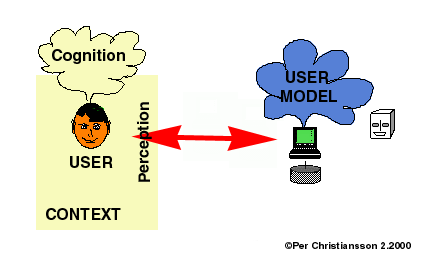
The computer contains a more or less explicitely described user model.
Merriam Webster:
- Cognition = the act or process of knowing including both awareness and judgement;
from co- + gnoscere to come to know - Perception = act of perceiving; awareness of the elements of environment through physical sensation
(Percieving = to become aware of through the senses)
From (Christiansson et.al., 1996) user models stereotypes were defined, user competence, usage profiles,
- what is your education pointed at (Project Manager, Civil Engineer,..)
- what is your primary task (user, developer, administrator, ..)
- what subjects do you have knowledge or interest in?
Interaction styles
- Direct manipulation
- Menu selection
- Form fillin
- Command language
- Natural language
Gardners Multiple Intelligences From (funderstanfinng - Gardner) below
- Verbal-Linguistic--The ability to use words and language
- Logical-Mathematical--The capacity for inductive and deductive thinking and reasoning, as well as the use of numbers and the recognition of abstract patterns
- Visual-Spatial--The ability to visualize objects and spatial dimensions, and create internal images and pictures
- Body-Kinesthetic--The wisdom of the body and the ability to control physical motion
- Musical-Rhythmic--The ability to recognize tonal patterns and sounds, as well as a sensitivity to rhythms and beats
- Interpersonal--The capacity for person-to-person communications and relationships
- Intrapersonal--The spiritual, inner states of being, self-reflection, and awareness
Further reading
- http://www.awl.com/cseng/titles/0-201-69497-2/website/lecture-notes/ch2-4.html, chapter 2.4 lecture notes in (Shneiderman, 1998, page 71) .
-
Christiansson P, Lagerstedt R, Engborg U, 1996, "User Models in Search and Navigation Systems on the Internet". AEC Applications of the Internet" AEC Systems Anaheim June 17-20.
(7 pp).
- Gardner H, 1991, "Intelligence in seven steps",
see also Funderstanding - Gardner, http://www.funderstanding.com/learning_theory_how7.html